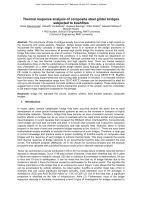Bridges

- Publication no: ABC2017-005-17
- Published: 20 April 2017
- PDF (free) Download
The occurrence of fires on bridges usually has a low probability but it has a high impact on the economic and social aspects. However, bridge design codes and standards do not explicitly incorporate fire safety concepts in design stage which is in contrast to the design provisions in building codes. With the occurrence of several high profile bridge fire incidents around the world, bridge fires have now become an area of concern. Furthermore, bridges in bushfire prone areas in Australia may be exposed to extreme fire conditions. It is noted that fire loads are dependent on quantity, type of fuel and the ambient conditions. Although concrete has a very good fire resistance capacity as it has low thermal conductivity and high specific heat. There are limited research investigations done on the fire performance of composite bridges.
In this study, a numerical analysis was undertaken on a steel composite girder bridge section using Abaquas software. Temperature dependent behaviours of material parameters of concrete and steel have been incorporated into the FE model to capture the thermal response of the system in terms of temperature development. Performance of the system have been analysed using a standard fire curve ASTM E119. Bushfire was simulated using experimental test site burning data available in literature. In a selected extreme bush fire event, the temperature range from 200°C-400°C increase can be experienced by steel for and up to 24 minutes. Fire exposed concrete surfaces could experience spalling.
These observations suggest that a more comprehensive thermo-mechanical analysis of the system could be undertaken to aid major bridge inspections subjected to fire damage.
